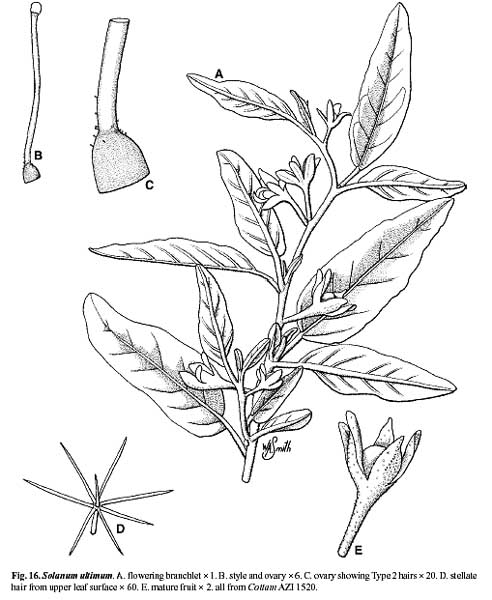 Line drawing by W.A.Smith of Solanum stenopterum in Austrobaileya 6: 681, fig. 16 (2004). |
 Map reproduced from Bean (2004) since this species does not yet map in Australia's Virtual Herbarium. |

Synonymy
Solanum ultimum A.R.Bean, Austrobaileya 6: 680 (2004).
T: 3 km by road south then west of 'Warang' homestead site, White Mountains NP, 11 Apr. 2000, M.B.Thomas 1572 & E.J.Thompson; holo: BRI; iso: DNA, NSW).
S. nemophilum var. brachycarpum Domin, op. cit. 585. T: Near Pentland, Mar. 1910, K. Domin s.n.; holo: PR, photo AD.
Description
Erect, rhizomatous perennial shrub, 0.3-0.6 m high. Juvenile stage unknown. Adult stem prickles absent. Adult branchlets white, grey or yellow; prickles absent; stellae very dense, 0.6-0.9 mm diameter, stalks 0-0.1 mm long; lateral rays 7-9, porrect; central ray 0.4-0.8 times as long as laterals, not gland-tipped; finger hairs absent; Type 2 hairs absent.
Adult leaves lanceolate or ovate, entire; lamina 4-6 cm long, 1.1-2.3 cm wide, 2.7-3.6 times longer than broad, apex obtuse or acute, base cuneate or obtuse, oblique part 0-1.5 mm long, obliqueness index 0-2 percent; petioles 0.7-1.4 cm long, 16-23% length of lamina, prickles absent. Upper leaf surface green; prickles absent; stellate hairs confined to midrib, or distributed throughout; protostellae present; ordinary stellae very sparse to sparse, 0.4-4 mm apart, 0.25-0.4 mm cross, sessile; lateral rays 7 or 8, porrect; central ray 0.5-1 times as long as laterals, not gland-tipped; finger hairs absent; Type 2 hairs absent. Lower leaf surface white; prickles absent; stellae dense to very dense, 0.1-0.2 m apart, 0.4-0.6 mm diameter, stalks 0-0.1 mm long; lateral rays 8-9, porrect; central ray 0.2-0.8 times as long as laterals, not gland-tipped; finger hairs absent; Type 2 hairs absent.
Inflorescence supra-axillary, solitary or pseudo-umbellate, common peduncle absent; 1-3-flowered, with all flowers bisexual and 4 or 5-merous; pedicels 5-9 mm long at anthesis, same thickness throughout or markedly thicker distally, 0.9-1 mm thick at mid-point, prickles absent. Calyx tube 0.5-1.5 mm long, lobes elliptic, 4-6 mm long; prickles absent at anthesis; stellae dense to very dense, white, 0.4-0.5 mm across, stalks 0-0.1 mm long, lateral rays 8-9, central ray 0.4-0.8 times as long as laterals, not gland-tipped; finger hairs absent; Type 2 hairs absent. Corolla purple, 7-9 mm long, shallowly lobed, inner surface glabrous; anthers 3.5-4.5 mm long; ovary with Type 2 hairs only; functional style 5.5-7 mm long, erect, glabrous or with Type 2 hairs only.
Fruiting calyx with lobes exceeding mature fruit, prickles absent. Mature fruits 1 or 2 per inflorescence, globular, 6-9 mm diameter, red; mesocarp juicy, succulent; pedicels 7-12 mm long in fruit, 1.5-1.9 mm thick at mid-point; seeds pale yellow, 2.4-2.7 mm long.
Original description from protologue (Bean 2004), reproduced with permission.
Another description of this species can be seen in Bean's treatment of the eastern Australian species at http://delta-intkey.com/solanum/www/ultimum.htm
Distribution and ecology
A Queensland endemic known from White Mountains NP and from the Barcaldine area. It is found in red sandy soil in eucalypt woodland.
Relationships
Treated as part of the S. densevestitum group of the subg. Leptostemonum (Bean 2004), together with S. gympiense, S. hapalum, S. innoxium, S. densevestitum, S. johnsonianum and S. nemophilum.
Derivation of epithet
From the Latin ultimus, meaning ‘most distant’, a reference to the geographical remoteness of this species from its relatives on the eastern Australian coast.
Selected specimens
QLD: BURKE DISTRICT: White Mountains N.P., near 'Warang', Mar 2000, Wannan 1624 (BRI, NSW); 0.5 km W of 'Warang' HS site,
As cited by Bean in protologue (Bean 2004).
Plant status, if any
Insufficient information is known about this species for any conservation status to be applied.
From the web
Further information and links for this species can be found on the Solanaceae Source site.